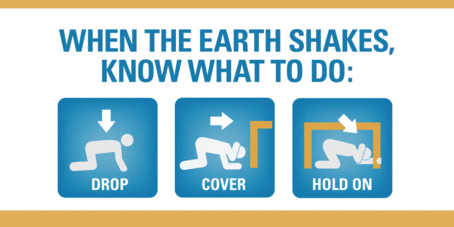
|
 |
|
After an unexpected earthquake
destroyed a school in Louisa County, VA, school administrators took action to
keep students, faculty, and staff safe in the future. Read their
story today!
|
The Great ShakeOut is tomorrow! Register today to join more than 22
million people from around the globe as they Drop, Cover, and Hold On at 10:15 AM local time to practice how to
respond to an earthquake. Practicing these steps is just one of the ways you
can prepare for tremors.
 Example of How to Drop, Cover, and Hold On
As with any disaster, there are several things you
can do to be safe. The Earthquake
Country Alliance (ECA) provides details about what to do before, during, and
after an earthquake to protect yourself and your family.
ECA’s Seven Steps to Earthquake Safety
will teach you how to survive and recover wherever you live, work, or travel.
The steps are:
- Secure Your Space
- Plan to be Safe
- Organize Disaster
Supplies
- Minimize Financial
Hardship
- Drop, Cover, and Hold
On
- Improve Safety
- Reconnect and Restore
To learn
more about these steps, visit the ECA website.
October is
National Cyber Security Awareness Month (NCSM). The Department of Homeland Security (DHS) sponsors this annual
initiative to educate the public about cybersecurity and increase national
resilience for cyber incidents.
Cybersecurity
is a shared responsibility in which we all have a role. Whether we use the
Internet at home, work, or school, there is a risk of identity theft, fraud, or
abuse. DHS has developed a series of events and activities to engage the public
during NCSM. Here are some things you can do to show your support:
- Post cybersecurity tips, news, and resources
highlighting NCSM on social media sites;
- Use the NCSM 2015 hashtag #CyberAware in your social media messages;
-
Join weekly NCSM Twitter chats every Thursday in October at 3
PM ET using hashtag #ChatSTC;
and
-
See what NCSM activities are happening in your area and
join.
For cyber
security resources you can use or share throughout the year, download the DHS Stop.Think.Connect. Toolkit. You can also test your knowledge
about cybersecurity in the Stop.Think.Connect. Online Safety Quiz.

The U.S. Fire
Administration (USFA) is sharing daily fire safety tips throughout the month of
October to help make homes and families safer. Now is a good time to review
important fire safety tips with your family, including how to properly use
portable fire extinguishers.
Portable fire
extinguishers are a valuable resource for immediate use on small fires, and can
save lives and property. However, before you consider using an extinguisher,
consider these very important details:
-
The U. S. Fire Administration
recommends that
only people trained to use and maintain a fire extinguisher consider using
them! Contact your local fire department for training in your area.;
-
The type of fire extinguisher you use should match the type of fire. For example, an
electrical fire would require a different extinguishing agent than a
grease fire. Most extinguishers display symbols to show the kind of fire
on which they can be used; and
- If you do not think you would be able to safely put the
fire out in five seconds using an extinguisher, do not attempt to use it!
Leave the area and call 911.
Should you need to use a fire extinguisher, follow the PASS method:
-
Pull the pin to break the tamper seal;
-
Aim
low, pointing the extinguisher nozzle, horn or nose at the base of the
fire;
-
Squeeze
the handle to release the extinguishing agent; and
-
Sweep
from side to side at the base of the fire until it appears to be out.
To learn more about fire safety, follow the
USFA hashtag #firesafein31 on Twitter at @usfire and on Facebook at www.facebook.com/usfire.
|
October 18 – 24, 2015 is America’s Safe Schools Week.
Many schools will be conducting activities to educate students and staff about school
safety procedures. Promoting a safe school environment also means preparing
students for emergencies that can happen during the school day.
Research shows that youth bring unique strengths to emergency
preparedness. In 2012, the Federal Emergency Management Agency (FEMA) created
the Youth Preparedness Council
(YPC) to bring together youth leaders from across the country who are engaged
in youth preparedness.
Council members are committed to involving other youth in various
community preparedness activities, including at schools. For example, Council
member Kiahna Lee Espia organized a Community Emergency Response Team (CERT) at
the Harvest Christian Academy in Guam. In addition to disaster response training,
CERT members also train in First Aid, Basic Life Support, and cardiopulmonary
resuscitation (CPR), skills that can be used to help injured students and
faculty if a disaster strikes the school. Visit
the YPC website to learn more about the exciting ways Council
members have engaged the youth in their communities.
During National Preparedness Month, The U. S
Department of Health and Human Services (HHS) organized a campaign to promote
teen preparedness. Follow #Teens4Prep on Twitter and check out this special videos series of
teens discussing how they prepare their communities
America’s
PrepareAthon! also help schools prepare for emergencies by providing
guidance on conducting discussions and holding table top exercises. Download hazard-specific
Playbooks and other valuable
resources today!
Disclaimer: The reader recognizes that the
federal government provides links and informational data on various disaster
preparedness resources and events and does not endorse any non-federal events,
entities, organizations, services or products. Please let us know about other events
and services for individual and community preparedness that could be included
in future newsletters by contacting citizencorps@fema.dhs.gov.
|

|